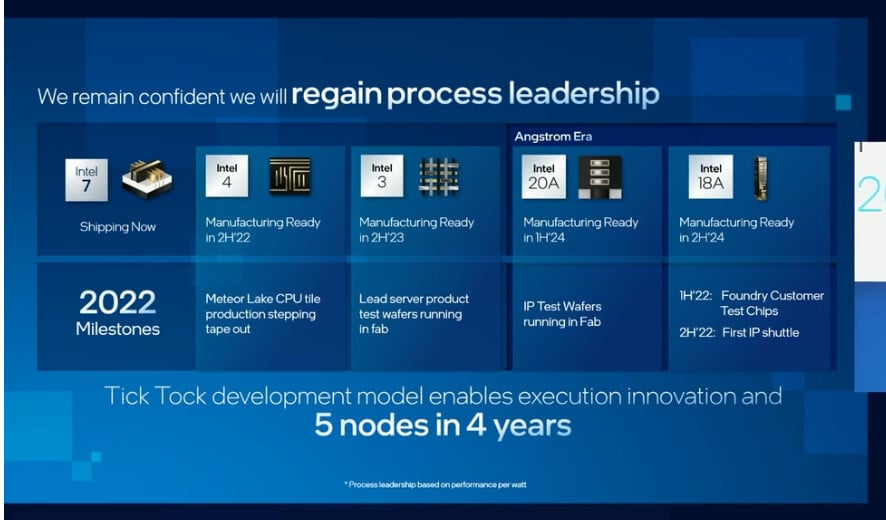


The company appears to be de-coupling its server, client desktop, client-mobile, GPU/XPU accelerators from each other, with the development of specific nodes for each. Intel unveiled the new "Arrow Lake" client microarchitecture being developed on the Intel 20A node, with product-launches expected in 2024, and wafer production in 2023. Later that year, the company will debut the Intel 18A (18-angstrom) node. The Intel 20A (20-angstrom) node is being designed for a specific category of Intel processors slated for the first half of 2024. Following this, Intel, along with several other foundry companies, enter the tricky sub-2 nm class. The Intel 3 node is targeted for a year later in late-2023, with the server processor that succeeds "Sapphire Rapids" being developed for this node. Intel 4 debuts with "Meteor Lake" mobile architecture slated for the first half of 2023, with mass-production of wafers commencing in 2H-2022. When laying out its upcoming foundry nodes following the current Intel 7 (10 nm enhanced SuperFin), the company mentioned its successors, starting with Intel 4 (7 nm EUV-based), which offers electrical properties and transistor densities in the league of 5 nm-class nodes by TSMC. The company has, for the first time in over 6 years, mentioned the tick-tock development cadence in its Investor Day presentation. Faintuch said.The "tick tock" product development cycle, which enabled Intel to develop a new silicon fabrication node every alternating year, a new microarchitecture every alternating year, and interleaving the two in such a way that each new microarchitecture is built on two successive nodes, and each node is used for building two succeeding microarchitectures, is back. Now, the market sector’s makes up “little more than 50%” of the company’s revenues, Mr.
#Intel tick tock Pc#
In 2014, the PC market made up around 70% of Intel’s revenues. These new segments include autonomous cars, the development of complete solutions for fifth-generation mobile internet, solutions for data centers, and products designed to enhance hard drives’ speed. In recent years, Intel has pivoted from a focus on PC chip development and now invests many resources in entering new segments and preparing for the next computerized revolution. We significantly cut the time it takes to bring products to market.” Thats why since 2016, a 'process architecture optimization' model has been developed. Both the processor and the architecture go through waves of innovation,” Mr. new micro-architecture (Tock) Intel Process-Architecture-Optimization Development Model The tick-tock model, which has been in use for more than a decade, is no longer sustainable, as Intel announced in summer 2015. This model means that we can do many more variations with each chip. “So I retired the tick-tock model and introduced a new model called Multi-Wave.

“I saw an opportunity to develop new products, enter many more segments and increase the value of the architecture,” Mr.
#Intel tick tock upgrade#
Each dual-cycle would see the company upgrade its manufacturing facilities in a costly process. During the ‘tock’ cycle, Intel focused on developing new chip architectures. In 2014, Intel was operating according to its two-year development model dubbed ‘tick-tock.’ During the ‘tick’ cycle, Intel concentrated on developing manufacturing processes, increase transistor density and expand the capabilities, performance, and efficiency of existing microarchitectures. “To enter multiple new areas of activity we had to shake up the way Intel was handling development,” Mr. Faintuch was faced with a complex task-to get Intel out of its ‘funk’ and help win back its once central position as a market leader and innovator.


 0 kommentar(er)
0 kommentar(er)
